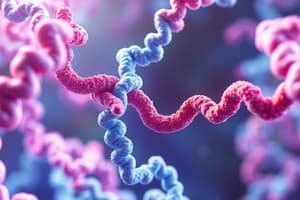Podcast
Questions and Answers
What are the basic building blocks of all proteins?
What are the basic building blocks of all proteins?
- Lipids
- Nucleotides
- Carbohydrates
- Amino acids (correct)
Which amino acids must be obtained through diet?
Which amino acids must be obtained through diet?
- Non-essential amino acids
- Trans amino acids
- Saturated amino acids
- Essential amino acids (correct)
Which bonds link amino acids together to form proteins?
Which bonds link amino acids together to form proteins?
- Covalent bonds
- Ionic bonds
- Peptide bonds (correct)
- Hydrogen bonds
What type of protein is formed by the hydrolysis of simple proteins?
What type of protein is formed by the hydrolysis of simple proteins?
Which of the following is an example of a complex protein?
Which of the following is an example of a complex protein?
How are non-essential amino acids characterized?
How are non-essential amino acids characterized?
Which classification of protein is formed from secondary degeneration products?
Which classification of protein is formed from secondary degeneration products?
What does the term 'protein' derive from in Greek?
What does the term 'protein' derive from in Greek?
What are considered complete proteins?
What are considered complete proteins?
Which type of protein is typically low in one or more essential amino acids?
Which type of protein is typically low in one or more essential amino acids?
What role do proteins play in the body's acid-base balance?
What role do proteins play in the body's acid-base balance?
What can be a consequence of inadequate protein synthesis during critical illness?
What can be a consequence of inadequate protein synthesis during critical illness?
Which of the following is NOT a function of proteins in the body?
Which of the following is NOT a function of proteins in the body?
What is a typical example of partially complete protein?
What is a typical example of partially complete protein?
What is edema, and what can cause it?
What is edema, and what can cause it?
What initiates the digestion of proteins in the body?
What initiates the digestion of proteins in the body?
Which of the following describes complementary proteins?
Which of the following describes complementary proteins?
Which type of protein generally contains all nine essential amino acids?
Which type of protein generally contains all nine essential amino acids?
What are the three possible fates of amino acids and peptides in the intestinal cells?
What are the three possible fates of amino acids and peptides in the intestinal cells?
Which symptom is typically associated with Kwashiorkor?
Which symptom is typically associated with Kwashiorkor?
How does a high-protein diet potentially affect heart disease?
How does a high-protein diet potentially affect heart disease?
What is the recommended protein intake for adults as a percentage of total food energy?
What is the recommended protein intake for adults as a percentage of total food energy?
Which of the following is an effect of high protein intake on kidney health?
Which of the following is an effect of high protein intake on kidney health?
What ratio of calcium intake to protein intake is recommended for adequate bone protection?
What ratio of calcium intake to protein intake is recommended for adequate bone protection?
Which type of protein consumption may lower the risk of certain cancers?
Which type of protein consumption may lower the risk of certain cancers?
What does the ingestion of protein powders fail to achieve in athletes?
What does the ingestion of protein powders fail to achieve in athletes?
Which condition results from a severe deficiency in both energy and protein?
Which condition results from a severe deficiency in both energy and protein?
What is the main symptom of muscle wasting in malnutrition related conditions?
What is the main symptom of muscle wasting in malnutrition related conditions?
Flashcards are hidden until you start studying
Study Notes
Overview of Protein
- Protein is essential in every living cell, including plants, animals, and microorganisms.
- The primary building blocks of proteins are amino acids and nitrogen, which result from protein digestion.
Amino Acids
- Amino acids are linked by peptide bonds to create various proteins.
- Classified into:
- Essential amino acids: cannot be synthesized by the body and must be obtained from the diet.
- Non-essential amino acids: can be synthesized by the body.
Types of Protein
- Simple Protein: yields only amino acids upon hydrolysis (e.g., albumins, globulins, enzymes).
- Complex Protein: includes non-protein groups (e.g., glycoproteins, phosphoproteins, lipoproteins, chromoproteins).
- Derived Protein: formed from the degeneration of primary and secondary protein forms (e.g., peptides).
Protein Sources
- Complete Protein: contains all nine essential amino acids; typically animal-based (e.g., meats, dairy).
- Partially Complete Protein: lacks sufficient essential amino acids for growth; some animal sources are included.
- Incomplete Protein: deficient in one or more essential amino acids and often plant-based (e.g., grains).
Protein Functions
- Tissue building: repairs and builds tissues.
- Energy source: can be utilized for energy.
- Plasma proteins: maintain osmotic balance (e.g., albumin).
- Defense system: produces antibodies for immune response.
Acid-Base Regulation
- Proteins help maintain acid-base balance by attracting hydrogen ions to buffer solutions.
- Normal pH range for blood and body fluids is between 7.35 and 7.45.
Transportation
- Proteins transport nutrients, oxygen (e.g., hemoglobin), and lipids throughout the body.
- Some proteins function as membrane transporters for vitamins and minerals.
Fluid Balance Regulation
- Plasma proteins usually do not cross blood vessel walls; however, during illness, they can leak and attract water, causing edema (swelling).
- Edema can arise from protein losses due to inflammation, inadequate protein synthesis, or insufficient protein intake.
Digestion and Absorption
- Digestion begins in the stomach and involves hydrolysis by HCL and proteolytic enzymes, breaking proteins into polypeptides.
- Amino acids are absorbed in the small intestine and can:
- Enter circulation for enzyme synthesis.
- Convert to different amino acids.
- Be oxidized for energy.
Protein Sources in Foods
- Notable protein sources include casein in milk, albumin in eggs, and gluten in wheat products.
Protein Deficiency
- Protein-energy malnutrition (PEM) includes:
- Kwashiorkor: severe protein deficiency characterized by edema, muscle loss, and brittle hair.
- Marasmus: severe energy and protein deficiency with symptoms like weakness and growth retardation.
Health Implications
- High-protein diets related to heart disease due to saturated fats in animal proteins.
- Red and processed meats linked to increased cancer risk.
- High protein intake can increase calcium excretion, impacting bone health (osteoporosis).
- Protein does not cause kidney disease, but excessive intake can strain kidneys and worsen chronic conditions.
Recommended Protein Intakes
- Protein should make up 10-35% of total energy intake.
- Recommended dietary allowance (RDA) for adults is 0.8 grams per kilogram of body weight.
Protein Supplements
- Protein powders are often misunderstood; muscle growth is primarily through exercise, not supplements.
- Most athletes may not require additional protein beyond normal dietary intake.
Studying That Suits You
Use AI to generate personalized quizzes and flashcards to suit your learning preferences.




